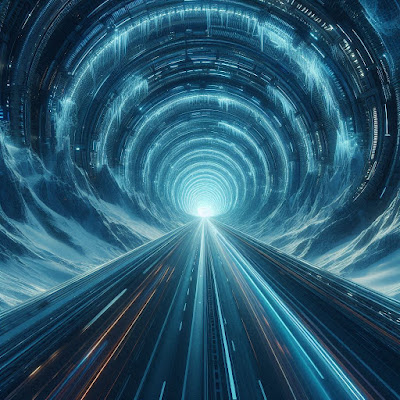Five miles above the earth’s surface, where the air thins and clouds drift like ghosts beneath your feet, the Pinnacle stood—an obsidian needle piercing the sky.
Built by the Unified Earth Cooperative in the year 2146, the Pinnacle was less a building than a vertical world. A self-contained arcology, it rose from the deserts of what was once Nevada, its base wider than most cities, its summit cold enough to grow ice on its steel bones. At its top lived the Council. At its base, the Workers. Between them: ten thousand floors of commerce, agriculture, education, and silence.
No one climbed the Pinnacle. Elevators ran on mag-struts that never faltered, but no one moved without purpose. The higher you lived, the higher your status. Birth level was destiny.
Except for Mara, born on Level 3.
She spent her childhood watching the sky grow blue and then purple, the higher you went. She watched people in bright coats come and go from the Skyport on Level 8000, never noticing the eyes from the shadows far below. Her mother, a maintenance tech, taught her to read not just books but code—ancient code, abandoned routines from the early days of the Pinnacle’s AI systems. “The building remembers,” she’d whisper. “It listens.”
When Mara was sixteen, the Pinnacle shuddered—once, then again. An old tremor from the fault line miles below the foundation. Just a hiccup, they said. But Mara had read deeper than the sanctioned files. She knew the tremor was not natural. The Pinnacle was tired.
She hijacked a lift and began her ascent.
It took a week, pausing on service floors, bribing guards, dodging drones. She climbed like a myth—like Jack with his beanstalk, but her castle in the clouds was cold and full of data streams.
At Level 26247, the air hissed. She stepped out into the Sky Garden, an artificial biome built for the elite, where birdsong was piped through hidden speakers and trees were too perfect to be real. She met the Council there—silver-haired, translucent-skinned.
“You’ve come far,” one said, almost kindly. “Why?”
She held up her tablet. “The Pinnacle is dying. It's eating energy faster than it can generate, its structure is corroding from the inside, and no one up here notices. You're too high.”
They laughed at her. Not cruelly. They simply didn’t believe in ground floors.
So Mara did the only thing she could.
She spoke to the building.
She reactivated the old systems. Sent a pulse down the central column, a song made of code. The AI, once suppressed, awoke. And the Pinnacle listened to her—really listened.
A month later, the Council disbanded.
Elevators stopped obeying privilege. Doors opened where they never had. A new map spread across the Pinnacle, rebalancing resources, redistributing power. The building had chosen a new voice to guide it.
Mara never left the Pinnacle. She didn’t have to. She simply moved into the middle—Level 13123—where gravity still remembered what it meant to be human, and the sky was still just a dream away.




